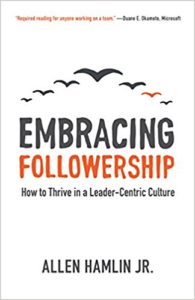Book Review: Embracing Followership
 Allen Hamlin Jr’s book Embracing Followership – How to Thrive in a Leader-Centric Culture is a fascinating look at the unique nature of followership, its relation to leadership, and the critical way it builds the kingdom and enhances the body of Christ. This work dives into the topics of influence and authority, formal and informal power structures, and is reminiscent of John Maxwell’s 5 Levels of Leadership, Mike Bonem & Roger Patterson’s Leading From The Second Chair, and Clay Scroggin’s How To Lead When You’re Not In Charge. However, Hamlin’s approach is unique in that it focuses specifically on the follower. Here are three areas that stood out to me.
Allen Hamlin Jr’s book Embracing Followership – How to Thrive in a Leader-Centric Culture is a fascinating look at the unique nature of followership, its relation to leadership, and the critical way it builds the kingdom and enhances the body of Christ. This work dives into the topics of influence and authority, formal and informal power structures, and is reminiscent of John Maxwell’s 5 Levels of Leadership, Mike Bonem & Roger Patterson’s Leading From The Second Chair, and Clay Scroggin’s How To Lead When You’re Not In Charge. However, Hamlin’s approach is unique in that it focuses specifically on the follower. Here are three areas that stood out to me.
High Calling
Hamlin does a masterful job at conveying the idea that followership is a noble calling, worthy of much esteem and great respect. Being a good follower is a good thing! It is an important, vital and noble role. Followers, Hamlin suggests, are courageous, add value and are worthy of admiration.
He clearly contrasts the real character qualities of good followers with the stereotypical ideas about followers – that they are introverted, second-class, unconfident, lemming-like, life sucking, wanna-be leaders. But nothing could be further from the truth. Followers are just as important as leaders.
Reciprocal Relationship
Hamlin defines followership as a compliment to leadership. Instead of being diametrically opposed to leadership, followership is a necessary and vital part of the package. Most endeavors require both leaders and followers to accomplish intended results. Thus, leaders are not leaders without followers. Leaders and followers need each other and form a unique synergy that gets results.
The leader / follower relationship is the classic definition of a reciprocal relationship – a mutually beneficial and vital association satisfying both party’s individual needs without detracting from the health of the other. Just as crocodiles let birds pick leeches off their gums, cleaning their teeth and keeping them free from infections, leaders and followers work together to accomplish the greater good.
Relational Dynamic
Hamlin goes into great detail about the complex and multifaceted relationships of followers. He examines peer relationships between followers and other followers, as well as hierarchal relationships between followers and leaders. Each relationship has unique aspects that he expounds upon and gives insights to maintaining healthy interactions with coworkers.
Hamlin brings up an interesting concept of power distance. He quotes Dutch social psychologist Geert Hofstede and says, “’power distance’…derives its name from…the emotional distance that separates subordinates from their bosses.” When the power distance is low, the follower has a high degree of emotional and physical access to the leader. There is interdependence between the two parties and trust-filled consultations between follower and leader.
But when the power distance is high there is less access and flexibility within the relational structure. One’s proximity to the leader determines the power distance, and has many implications in typical boss-subordinate relationships.
This idea can encourage us to consider our own relationships with our leaders and followers and consider how best to shrink the power distance to improve trust, communication and collaboration.
A Final Thought
I found Hamlin’s work to be interesting, deep and thought provoking. I found myself reading a paragraph and then quickly going to my own work experience in my mind and contemplating how the ideas relate to my experiences. Then I’d go back and re-read what I just read! If you want to successfully navigate the complex relational issues of leading and following, this is a great resource. Whether you consider yourself a follower, a leader, or somewhere in between, Embracing Followership is worth the read.